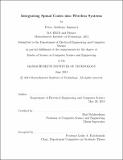Integrating spinal codes into wireless systems
Author(s)
Iannucci, Peter Anthony
DownloadFull printable version (3.789Mb)
Other Contributors
Massachusetts Institute of Technology. Department of Electrical Engineering and Computer Science.
Advisor
Hari Balakrishnan.
Terms of use
Metadata
Show full item recordAbstract
Rateless spinal codes [47] promise performance gains for future wireless systems. These gains can be realized in the form of higher data rates, longer operational ranges, reduced power consumption, and greater reliability. This is due in part to the manner in which rateless codes exploit the instantaneous characteristics of the wireless medium, including unpredictable fluctuations. By contrast, traditional rated codes can accommodate variability only by making overly conservative assumptions. Before spinal codes reach practical deployment, they must be integrated into the networking stacks of real devices, and they must be instantiated in compact, ecient silicon. This thesis addresses fundamental challenges in each of these two areas, covering a body of work reported in previous publications by this author and others [27, 26]. On the networking side, this thesis explores a rateless analogue of link-layer retransmission schemes, capturing the idea of rate adaptation and generalizing the approach of hybrid ARQ/incremental redundancy systems such as LTE [29]. On the silicon side, this thesis presents the development of a VLSI architecture that exploits the inherent parallelism of the spinal decoder.
Description
Thesis (S.M.)--Massachusetts Institute of Technology, Dept. of Electrical Engineering and Computer Science, 2013. This electronic version was submitted by the student author. The certified thesis is available in the Institute Archives and Special Collections. Cataloged from student-submitted PDF version of thesis. Includes bibliographical references (p. 85-88).
Date issued
2013Department
Massachusetts Institute of Technology. Department of Electrical Engineering and Computer SciencePublisher
Massachusetts Institute of Technology
Keywords
Electrical Engineering and Computer Science.